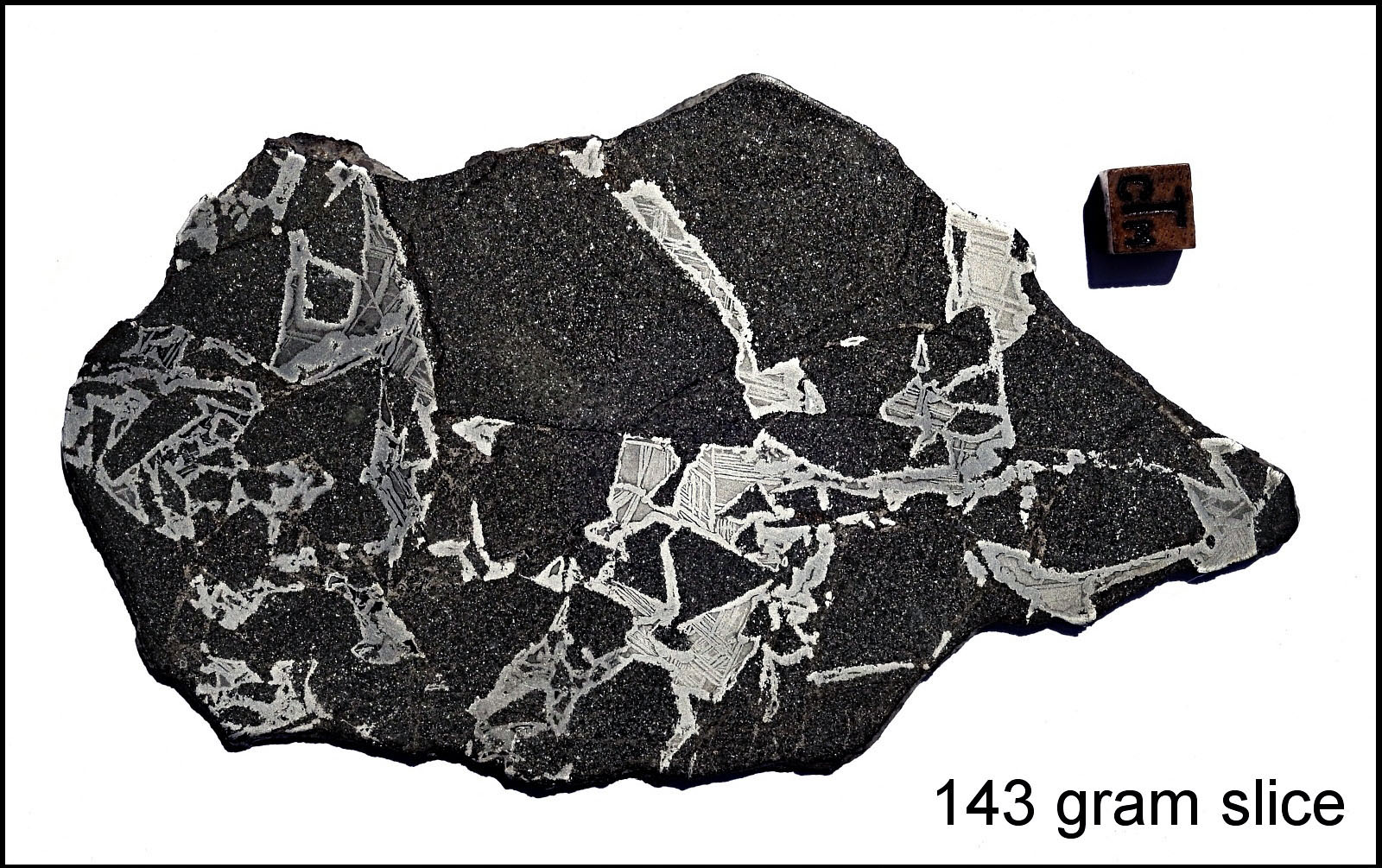|
Roll Overs:
#1
#2
#3
#4
#5
#6
#7
#8
#9
#10
#11
|

|
|
Copyright (c) Steve Brittenham.
|
2 specimens - 143 grams and 156 grams. H6
TKW 71.4 kg. Observed fall 13 June 1998, Roosevelt County, New Mexico, USA.
From the MetBul:
After detonations were heard and smoky trails seen in the sky, a shower of meteorites landed near Portales, New Mexico. 53 objects have been recovered, with a total mass of 71.4 kg. The largest pieces weighed 16.5 kg (witnessed to fall by Nelda Wallace and Fred Stafford), 17.0 kg (found by Elton Brown), and at least nine others over 1 kg. A 530 g fragment went through the roof of Gayle Newberry's barn and embedded itself in a wall, indicating a trajectory west to east. The elliptical strewn field is approximately 7.7 x 2 km, trending N60–65ºE, although recent reports may extend this somewhat.
     
Steve writes:
These Portales Valley slices were polished and etched by Rob Reisener for his friend Skip Wilson (Skip is known for almost 70 meteorite finds to his name!). Skip actually witnessed the June 13, 1998 fall – it was near his house – and subsequently found several stones.
These slices were from Skip’s largest find – a 12¼ pounder that only produced about a half dozen or so slices that contained large amounts of metal within the stone matrix. Of those, one was kept by the University of Arizona in lieu of cutting fees, another was traded to KD Meteorites, and these were among the last of three to be polished and sold. I was torn on which to keep, so I ended up buying two.
The 143 gram slice was imaged under bright light to best show its Widmanstätten patterns (photos 1 & 2). The 156 gram slice was taken with glancing sunlight and shows its size relative to my hand (photos 3 & 4).
Portales Valley was the first stone meteorite to exhibit Widmanstätten patterns in its metal veins, and these slices also exhibit rings around the metal’s crystalline structure that aren’t seen in all examples from this fall (photo 5). Troilite is present in some areas, as well as a few non-structural fractures. Dr. Alex Ruzicka told me Portales Valley is fairly depleted of olivine, and the yellowish crystals found mostly at the boundaries between metal and the neighboring silicate-rich matrix are actually phosphate minerals (photo 6).
Dr. Ruzicka believes that because of its unique combination of coarse (cm-sized) graphite nodules, a stone matrix with much lower metal than traditional H chondrites, and metal in the form of veins that exhibit Widmanstätten structures, Portales Valley is not an ordinary H6 stone chondrite, but instead is the first metallic melt breccia – a transitional stage between chondrites and various classes of differentiated meteorites (he coined the name portalesite for it). Alternately, Dr. Alan Rubin suggests the metal in the stone separated from impact melting, the troilite was reintroduced by an S2-rich vapor, and the Widmanstätten patterns formed from slow cooling because the metal was pushed deep inside the parent body. Other explanations for how Portales Valley formed include the notion that it may be transitional between the ordinary chondrites and the silicated IIE-iron group.
And Portales Valley is also a hammerstone, as one piece punctured the roof of Gayle Newberry’s barn and embedded itself in a wall, giving scientists the ability to establish a southwest to northeast trajectory of the meteor as it fell.
I was able to acquire and photograph a thin section of the stone material (photo 7 is a low resolution, full image view with outlines that show the areas magnified in photos 8 & 9 to illustrate its rare chondrules and photos 10 & 11 that shows some additional interesting features). Its zoomable, high-res two gigapixel stitch of 156 individual 18 megapixel images can be seen here.
|
|
|
| |
|
|
Tomorrow
| Marsabit (prov) |
 |
| Andrey Jerochov |
This Month

|
John Divelbiss
8/22/2020 9:29:17 AM |
fair enough Steve...I hope the split between my sons will have balance too |
Steve Brittenham
8/21/2020 10:51:00 PM |
Hi John. Both specimens have unique features, which is why I ended up with two. And when my son and daughter inherit the collection, at least this will be one fall they don't have to argue over! |
John Divelbiss
8/21/2020 5:55:45 PM |
wonderful specimens...if you ever decide which one you want to keep Steve, I think there maybe interest in the other slice. |
Steve Brittenham
8/21/2020 5:07:28 PM |
Thanks, guys, for the nice comments. I like to learn as much as I can when I acquire a new meteorite. But I always have to write it down, because all that great information out there just doesn't stick in my old brain!! |
Bernd Pauli
8/21/2020 4:41:34 AM |
Thank you, Steve, for all these interesting details on this extraordinary meteorite, and, of course, for the excellent photos! |
Graham Ensor
8/21/2020 4:35:27 AM |
Nice write up about these specimens...Portales Valley is quite an inigma. One of my favourites. |
| |
|